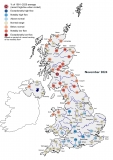Submitted by Katie Muchan on
April was a transformative month, with little appreciable rainfall and widespread river flow recessions in dramatic contrast to the record-breaking wet weather and flooding only two months ago. For the UK as a whole, it was warm (the fifth warmest April in a series from 1910) and sunny (the sunniest April in a series from 1929), with some wildfires reported in Scotland and Northern Ireland. At the national scale rainfall was less than half the average, with a large swathe of northern Britain registering less than a third of average. The Northumbria region recorded its driest month since records began (in 1910). Correspondingly, river flows were substantially below average across large parts of the north and west with new record low April mean flows in several catchments. By month-end, flows approached or surpassed seasonal minima and in some catchments in north-west England flows were lower than those recorded in previous notable drought events. Soil Moisture Deficits (SMDs) increased markedly during April and for the UK, late-April soils were the second driest (behind 2011) in a series from 1961. Groundwater levels fell at nearly all index sites but generally remained above normal or higher, following the healthy recharge season over the winter. Reservoir stocks at the end of April were moderately below average at the national scale, however, some individual impoundments in Scotland and northern England were nearly 20% below the average for the time of year. Given the current hydrological situation of drier than average soils, low river flows and depleted reservoir stocks in some impoundments, close monitoring of the development of these deficits is required as we move towards summer. Furthermore, the current outlook favours drier conditions extending into the early summer, increasing the likelihood of agricultural stress and environmental impacts of low flows in the coming months, with the potential for localised water resources pressure later in 2020.



